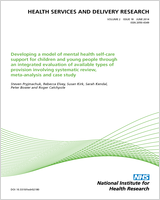NCBI Bookshelf. A service of the National Library of Medicine, National Institutes of Health.
Campbell JL, Fletcher E, Abel G, et al. Policies and strategies to retain and support the return of experienced GPs in direct patient care: the ReGROUP mixed-methods study. Southampton (UK): NIHR Journals Library; 2019 Apr. (Health Services and Delivery Research, No. 7.14.)

Policies and strategies to retain and support the return of experienced GPs in direct patient care: the ReGROUP mixed-methods study.
Show detailsOur projections of future practice workloads were based on the number of patients registered at each of the 423 general practices in south-west England, in 5-year age bands, split by gender combined with subnational population projections from the ONS as described in Chapter 6. The approach comprises the following five steps.
- Assess congruency of ONS predictions with list size (Figure 15). ONS subnational population projections were compared with GP list size data aggregated to CCG level for 2014, 2015 and 2016. This provided an assessment of the degree to which ONS predications reflect the actual GP list size data in those years. An example comparison is shown below, where it can be seen that although the practice population data indicates a higher population than the ONS projections, variably by age group, the difference between practice population data and ONS projections is stable over time. This difference between the two data sources is most likely to be attributable to ‘list inflation’, caused by patients who have not been removed from the list following death, dual registrations for patients when moving homes or by a registered patient’s failure to complete the national census.173 Given that the average consultation times used to weight the populations are based on registered patients, we did not consider it appropriate to resize practice list sizes to reflect the identified difference.
- Calculate the proportion of the CCG population registered at each general practice. For each practice, and for each age-band-by-gender stratum, we identified the number of patients registered with the practice and the expected number of patients within a CCG for nine time points between April 2014 and April 2016. This allowed us to derive the proportion of the total CCG population by gender/age interval registered at each practice. If the number of practices in a CCG is declining over time, we might expect the proportion of the CCG to be rising at the remaining practices.
- Quantify trends in the proportion of the CCG population registered at each general practice. The data from step 2 were used as the outcome variable in a logistic regression model that included a linear term for time as well as a categorical variable for quarter to quantify trends. A separate regression model was used for each practice-by-age-band by gender stratum.
- Determine the projected count of patients. We used the resultant regression equation to predict the proportion of CCG patients by practice/gender/age-interval for 5 years beyond the final data point. Multiplying this proportion by the ONS predicted population for the same time point gives a projected count of patients.
- Project adjusted list size. The projected populations were used to create a projected adjusted weighted list size using the same algorithm used above for observed populations.

FIGURE 15
Comparing GP list size data with ONS data for NHS Bath and North-East Somerset CCG.
- Projecting future workload - Policies and strategies to retain and support the r...Projecting future workload - Policies and strategies to retain and support the return of experienced GPs in direct patient care: the ReGROUP mixed-methods study
Your browsing activity is empty.
Activity recording is turned off.
See more...